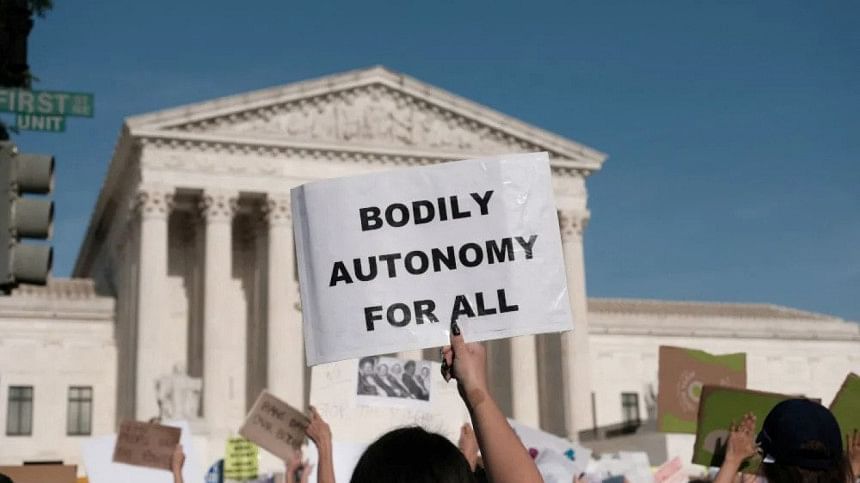Roe v. Wade and America’s Supreme Court Abortion Ruling Explained

The world stirred in their seats when the United States Supreme Court struck down the constitutional right to abortion on Friday, June 24, overturning the Roe v. Wade ruling that kept abortion legal in the US for the last 50 years. While this issue has been doing the rounds on the news for quite some time, a lot of people are confused about what does this mean and why it's so important.
What is Roe v. Wade
In 1973, a controversial case involving a pregnant Texas woman took place where she claimed that it is unconstitutional for state laws to deem abortion or an attempt to abortion as a crime. In a 7-2 vote, the Supreme Court reached the conclusion that indeed the right to abortion is a basic human right guaranteed by the 14th Amendment of the US constitution which stipulates that no one may be deprived of their life, liberty, or property without due process of law. While it provided women across the nation with bodily autonomy, it also set in motion controversial decades long debate as abortion is a sensitive matter. Conservatives questioned whether the Supreme Court should be able to come up with new fundamental rights based on the rather broad amendments of the US Constitution.
Why now
The ruling was a slow, deliberate effort of abortion critics who have, for decades, wanted to give back more power to the states within the United States of America. For decades, conservatives have wanted to replace liberal judges and justices and mold the courts so that more conservative rulings would take place.
The composition of the Supreme Court today is such that out of 9 justices, 6 of them are pro-life conservatives which has brought a significant ideological shift. Three of the conservatives were appointed by former Republican President Donald Trump and they were fundamental in the decision to overturn Roe v. Wade in a 5-4 vote and eliminate the basic right that women in the US held for so long.
The political structure of the USA and its influence
A defining characteristic of the American legal system has been the Supreme Court's adherence to its own precedents. In general, the court has held that it is crucial to uphold earlier decisions, even though succeeding groupings of judges may have reached a different conclusion. That strategy encourages consistency in the law and prevents the social disturbances that might result from radical changes in the court's rulings.
However, on occasion the court has overruled past decisions if most of the justices voted so and had solid justifications behind it. Since the Supreme Court is heavily conservative at present, the reasons behind abolishing the right to abortion were considered strong despite over two thirds of American believing otherwise.
Although President Joe Biden has called for Congress to restore the rights gained from Roe v. Wade as federal law, it is unlikely because right now, there is an even balance of power among the Democrats and Republicans in the Senate.
What it means for reproductive health laws
Reproductive rights are set to be altered almost immediately. Individual states get to decide whether abortion is legal or not, with half of the states likely to impose a ban. Here is where the inherent problem lies: state courts now have the ability to impose total bans in which case there may not be exceptions for rape, incest, or the mother's health. Furthermore, medication-induced first trimester abortions may also be illegal, which is currently one of the most common forms of abortion. This means women seeking an abortion would have to travel to the handful of states where it is still legal such as New York and California.
The impact
A step down for women's rights, eviscerating abortion rights will not stop people from seeking abortion. Widespread surveillance will ensue which means healthcare providers, family members, volunteers or just about anyone who is involved in a pregnancy that is not carried to term will be investigated for crime in addition to the pregnant women herself. It will especially complicate things for women with serious health conditions where the only treatment is a timely abortion.
The ones who will disproportionately be affected are the poor and the marginalised as millions of women do not have the financial resources to travel hundreds of miles to get the procedure done and thus many will succumb to at-home pills and find options that are illegal and hazardous to health. Furthermore, countless women use period tracking apps which could pose a threat as the data collected is not protected and could get into the hands of law enforcers.
References
1. The Wall Street Journal (June 25, 2022). What Does Overturning Roe v. Wade Mean? What to Know About the Supreme Court Abortion Ruling
2. The New York Times (June 24, 2022). What Does the End of Roe Mean? Key Questions and Answers.
3. CNN Politics (June 24, 2022). Supreme Court overturns Roe v. Wade
4. The New Yorker (June 24, 2022). We're Not Going Back to the Time Before Roe. We're Going Somewhere Worse

 For all latest news, follow The Daily Star's Google News channel.
For all latest news, follow The Daily Star's Google News channel. 








Comments